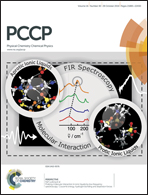Thermo-molecular orientation effects in fluids of dipolar dumbbells
Abstract
We use molecular dynamics simulations in applied thermal gradients to study thermomolecular orientation (TMO) of size-asymmetric dipolar dumbbells with different molecular dipole moments. We find that the direction of the TMO is the same as in apolar dumbbells of the same size, i.e. the smaller atom in the dumbbell tends to orient towards the colder temperature. The ratio of the electrical polarization to the magnitude of the thermal gradient does not vary much with the magnitude of the molecular dipole moment. We also investigate a novel second order TMO that persists even in size-symmetric dipolar dumbbells where molecules have a slight tendency to orient perpendicular to the gradient except very close to the hot region, where (anti-)parallel orientations are preferred. Finally, we investigate rotational correlation functions and characteristic rotational times in these systems in an attempt to model possible spectroscopic signatures of TMO in experiments. Although we cannot detect any difference in integrated rotational times between equilibrium simulations and simulations in a thermal gradient, more careful modelling of the anisotropic rotational dynamics in the thermal gradient may be more successful.



 Please wait while we load your content...
Please wait while we load your content...